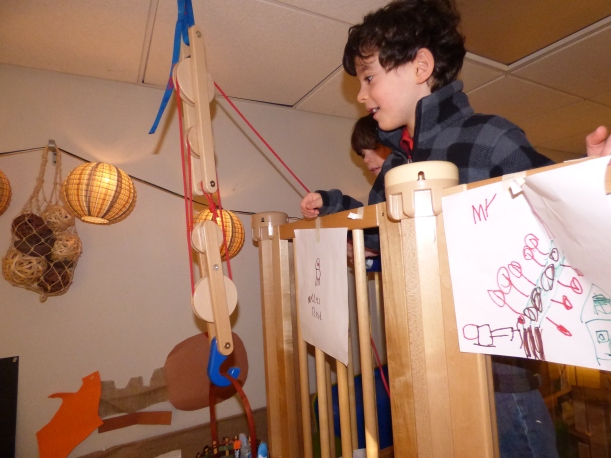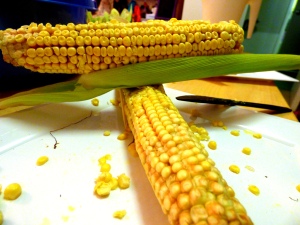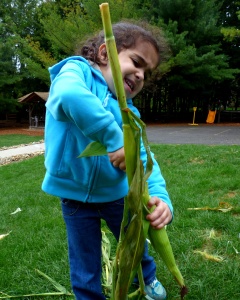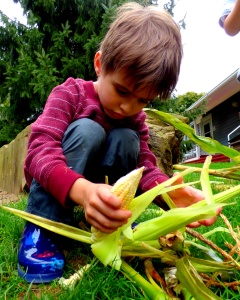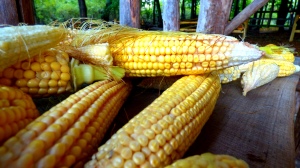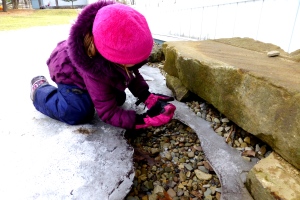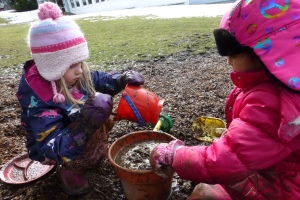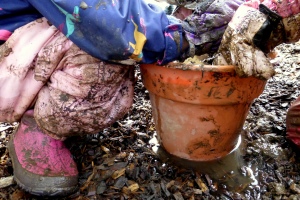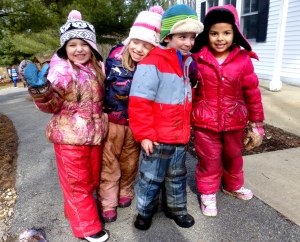Lemonade
We introduced our listening center last week. It’s an antiquated, child-friendly, audio-tape player. The children love the independence of being able to listen to a story by themselves. After a ten minute explanation about the “play” and “stop” button and how to care for the headphones, we sent a small group off to listen to “The Three Billy Goats Gruff.”
Oops!
None of the buttons worked! The power was on, the tape was happily in the machine, but the wheels wouldn’t turn. No playing, no fast forward, no story. Well, as they say, when life give you lemons….
We found the same book read-aloud on YouTube, but we wanted to make the experience special since they’d lost the use of the headphones. Enter the mini-theater.
It’s not so quaint as an audio-tape player, but they seemed to like it.

Heave-ho, me hearties!
When the students came back from winter break, they noticed that something new was added to the loft. They spent most of the morning studying the contraption and making guesses about how it could be used. The hook seemed to be the most recognizable part of the tool and it quickly was decided that it had to be an anchor. After some exploration, we sat down with the students to explain that the new tool was called a pulley and it was used for carrying various items from the top of the loft to the bottom and vice versa. The students spent a few minutes learning how to use the tool safely and troubleshooting how we could safely attach the rope to the loft. Then it was time to test it out!
The Key to Pre-K
In the past few days, the students have started showing a budding interest in keys. It began one day when two students asked to borrow our “teacher keys” to experiment with how they worked on the classroom door. Then they tried the outside door. They began to notice that certain doors only open with certain keys. When they realized that Mrs. Forst had more keys than I did, they wondered what the other keys could be used for.
As the interest started to grow from just two student to almost eight students, we thought that perhaps a morning provocation could expand the students’ knowledge of keys even further. This morning, we put out a giant bowl full of keys, some paper, and some black markers. The students began tracing the keys and noticed that there are many different sizes and shapes of keys. One student exclaimed, “I found a master key. It says ‘MASTER’ on it and this one is for a safe because it has an ‘S’ on it,”. Another student traced the keys and then cut them out so that they could play with them at home.
At morning meeting, we continued our conversation when one of the students mentioned that sometimes you need a locksmith to open doors for you. The students are still unsure of what a locksmith does exactly but are excited to find out! Marie and I are quite interested to see where this new found interest will take us!
Corny Art
With our haul of freshly shucked corn, we headed indoors to see what uses we might find. Although I cannot say which (I’m sworn to secrecy), one of the children already tasted the cobs and found them wanting. Edibility out of the question, what DO you do with a large batch of corn ears?
How about [butter] knife handling skills? Everyone needs more practice cutting up their own food. We wondered what strategies the children would use when given this common tool. We witnessed sawing, attempts at slicing and valiant efforts to hack the corn to pieces.

Of course, there’s painting. I mean, it IS pre-kindergarten. Add a bit of science experimentation, two colors of paint and some ears of corn and you get instant fun with secret learning. We saw patterns, comparisons and new language to describe the wet corn and the paint. A few of the children quickly dispensed with the corn and dove right in and began drawing and mixing with their fingers.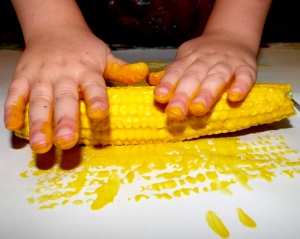
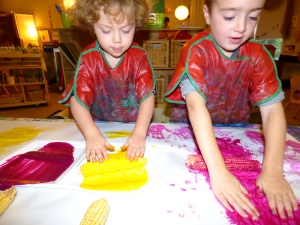 Finally, we had a few students who chose not to use the paint at all. Rather, they went for a more sculptural approach. Available husk pieces were tied around corn, used for “bedding” and added as shims to hold more vertical structures.
Finally, we had a few students who chose not to use the paint at all. Rather, they went for a more sculptural approach. Available husk pieces were tied around corn, used for “bedding” and added as shims to hold more vertical structures.
So, there was some corn…
 The decorations from Applefest made a comeback this week. Our hard-working custodial staff gathered up all of the corn stalks from the festival and prepared them for final transportation to the dumpster or compost pile. (Un??)Fortunately, our class found the pile first.
The decorations from Applefest made a comeback this week. Our hard-working custodial staff gathered up all of the corn stalks from the festival and prepared them for final transportation to the dumpster or compost pile. (Un??)Fortunately, our class found the pile first.
One child knew right away what treasure lay buried within the stiff green layers. Once corn was officially discovered, husking (or “shucking” as Mrs. Forst says) became the activity of choice.
It wasn’t always easy.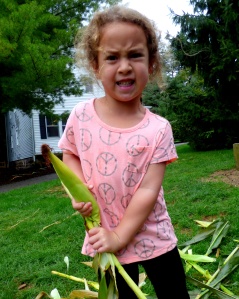
Yet, they never gave up.
And the reward was worth it.
As always, persistence pays off.
An Introduction to Painting
Pre-K Play: First Draft 2015
Many of you already know that our students have been hard at work writing the script for our Pre-K movie since the beginning of January. Now that we have finished our final draft, we thought it might be fun to look back at the development of our story. Below, you will find the first draft of our play. This copy of the script is written word-for-word as described to us by the students, so please ignore any run on sentences or the lack of actual dialogue. However, if you look closely, you’ll see their ability to include many important story elements such as a beginning/middle/end, as well as a problem and solution!
You’ll also notice that several students choose a character but then do very little in the actual play. Typically, we start each script writing session by acting out the story line that was previously written on another day. This helps the students to see how big or small their roles are and then gives them an opportunity to change it (if they so choose).
The students were allowed to make as many changes as they wanted to their characters or the story line until the beginning of March. Since then, we have begun practicing our lines and designing our costumes and sets. On May 8th, we have invited our videographer friend, Weird Eric (of WT Summer Camp and Applefest fame), to help film and turn this fantastic story into a movie! We are very excited to dive into the movie making process!
But first, please enjoy this little window into an exploration in script writing!
First Draft
N.M. – a flower
V.H. – Anna
Z.W. – Mickey Mouse Clubhouse
R.M. – a rainbow flower without a stem
A.H. – a baby unicorn
Z.B. – Elsa
P.M. – Mickey Wizard
L.W. – Woody the cowboy
L.L. – Snow White
J.K. – a forest guy
Once upon a time, Woody found a cage and he looked in and he said, “Wow there’s a little dog. Hey, you wanna play?” and they played together and he said, “I’m going to throw this football like a quarterback.”
Mickey Mouse Clubhouse plays football too and then he paints with his brother and then he calls the mickey wizard to come over to have a big party and they all play with their family. Then they have a sleepover. They heard Mickey Wizard crying. He’s crying because he lost his magic wand. Now he has to get a new one. So Mickey Wizard goes to the store to buy a new a wand.
Just then, they see a princess named Anna. Woody says, “Anna would you like to stay over”. And Mickey Mouse Clubhouse says “ok, we have 400 beds for you sleep in” and then Elsa comes and they invite her to stay. They tell her that there are 400 beds and that she can sleep with her sister and Mickey Mouse Clubhouse will stay with his brother. Just then, Mickey Wizard comes back from the store with a wand and he feels happy.
“Hello, Mickey Wizard,” they say. They tell him that there are 400 beds and he can stay with Woody in Mickey Mouse Clubhouse’s bed.
Elsa sees Snow white who is riding in on a baby unicorn and everyone invites them to stay for the sleepover. Everyone gets tired and they all go to sleep.
The next day everyone wakes up and they decided to go outside and play. When they get outside, they find two beautiful flowers and they pick the flowers. The forest guy says, you have to put those flowers into the water. So they take the flowers inside and put them in some water.
Then the baby unicorn gets lost! So everyone goes to look for the unicorn, except for Anna who stays home to take care of the flowers. They looked around and they realized that the monster had taken her into the cave. The forest guy hears a sound and he thinks it’s the baby unicorn and it was the unicorn. But Snow White says, “this will take forever to find the unicorn!”
Mickey wizard breaks the cave with magic from his wand and he uses his magic wand to bring the unicorn to him and to safety. The baby unicorn made it back to the house safely. Everyone says, “YAY!!!”
The End.
Of Liquids and Solids
Ah! Spring weather is upon us. We’ll see warmer weather, leaf buds, early crocuses and, of course….
MUD!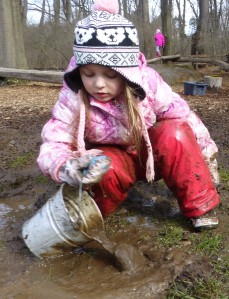
Wonderful, gooey, ooey, sticky, icky mud!
As the snow melts, the runoff creates a thin trickle that percolates down to the field. The tiny rivulet runs down the slight slope toward the grass, spreading wider with each inch.
Once solid footing becomes squishy and murky. Your boots call out, “schlp, schlp,” until you realize that only one boot is still making noise. The other is embedded in the mire. Hop, hop, hop back to your boot.
On the other side of the new swamp, friends concoct a meal fit for the king of ooze. Into the bucket go shovelfuls of solid and liquid H2o. Buckets of watery mud are carted to the pot, adding to the brew. To add more mud or stick with ice? Does it need more wood chips? Did you stir it twice?
http://www.youtube.com/watch?v=wWwhfpvZmi8
All this in a mess. A natural mess compounded by art. How to get clean, where even to start?
The snow! The snow!
We’ll roll in the snow. The abrasive top coat is just enough to scour our suits. We leave brown streaks behind to show where we’ve been.
http://www.youtube.com/watch?v=f2KoWgDAKn8
We’ve explored measurement, space and fluidity, too. We’ve mud on our face. It’s time to go in.
Big Body Letters
This morning, our students got excited about trying to figure out how to make various letters using only their bodies. Not only did the students have to access their knowledge about letters and the shapes we use to represent them, but they had to work cooperatively to move their bodies to make the correct formation. Using directional language, the students (and sometimes the teacher) guided each other to twist, curve, or straighten their bodies so the letter could take shape.


